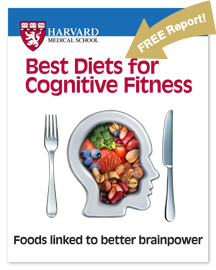The new dietary dos and don'ts
Every five years the federal government issues new dietary guidelines that are supposed to put the country on the road to healthier eating. Apparently Americans have been taking some wrong turns because two thirds of us are now overweight and nearly a third are obese (a body mass index of 30 or greater).
Weight control and exercise have been mentioned in the guidelines before, but the new set released in January 2005 puts them front and center where they belong. They give better advice about grains and cereals: At least three of the six daily servings are supposed to be whole grains. They also make a stronger statement about difference between the "good" and "bad" fats.
The dietary guidelines have trickledown effects on school lunch and other government programs, even if many Americans aren't aware of the particulars. The new guidelines are especially important because they will be used to update the familiar Food Guide Pyramid.
Dr. Walter Willett, a member of the Health Letter's editorial board and chair of the Harvard School of Public Health's nutrition department, is happy about the emphasis on weight control and the approach to dietary fats. He says, though, that the carbohydrate recommendations could have been stronger, noting that they still allow three servings a day of nutritionally-empty refined starches. And Dr. Willett says the recommendation that we have three servings of fat-free or low-fat dairy products a day is a mistake — and a big win for the dairy industry: "In reality, large studies have consistently shown no reduction in fracture risk with high dairy intake, but many studies have shown a higher risk of prostate cancer."
Here are some highlights of the guidelines:
Weight management. Prevention is the best policy. Many of us could avoid weight gain in the first place by shaving 50–100 calories from our diets. The guidelines note that although the 2,000-calorie-a-day diet remains the reference diet, it's not the recommended one. Many Americans should be eating far fewer calories than that. They say the best way to cut calories is to reduce the so-called discretionary ones that come from added sugars (in soft drinks and candy, for example), added fats, and alcohol.
Physical activity. Why do dietary guidelines include recommendations about physical activity? Because regular physical activity, as much as anything we eat, is essential to maintaining a healthy body weight.
Past guidelines have said that 30 minutes of exercise a day will reduce chronic disease risk and have other health benefits. The new ones say that most of us need an additional 30 minutes of moderate-to-vigorous physical activity to avoid gaining weight.
An hour of exercise a day — that sets the bar pretty high. But you don't have to work out in a gym: Examples of moderate-level physical activity include gardening, dancing, and walking at a 3 1/2-mile-per-hour pace. And short, 10-minute bouts of activity have benefits similar to longer stretches so long as you reach the same daily total. So give yourself credit for the brisk walk from where you parked your car and similar activities.
Dietary fat. Most of the fat you eat should be the "good" polyunsaturated and monounsaturated fats found in fish, nuts, and vegetable oils (corn, olive, soybean, etc.). Less than 10% of your daily calories should come from saturated fat, found primarily in meat and dairy products.
For the first time, the guidelines take a strong stand against the trans fats created by partially hydrogenating vegetable oils, saying you should eat as little trans fat as possible. Some experts were hoping they'd set a definite daily limit (1–2 grams), but Dr. Willett says the guidelines got it right. Trans fats are used to make baked goods and snack foods so they stay fresh longer. Other major sources include french fries and many stick margarines.
Carbohydrates. Fruit, vegetables, all grain-based foods, dairy products — they all contain carbohydrates, which in the good old days we called sugars and starch. The trick isn't to boycott carbohydrates, but to make sure they arrive on our plates in packages — such as whole grains and in fruits and vegetables.
The guidelines aren't very bold on the extra, empty carbohydrates from added sugars (the "more research is needed" refrain is sounded). The advice is to limit intake as part of the general limit on discretionary calories.
Potassium. Potassium offsets sodium's effect on blood pressure and has other health benefits. Your daily diet should include 4,700 milligrams of the mineral. Potassium-rich foods include bananas, leafy green vegetables, and potatoes. Meat, milk, and some cereal products contain potassium but in a form that is difficult to absorb.
Fruit and vegetables. One of the first principles of healthy eating is to choose nutrient-dense foods that pack, calorie-for-calorie, the most amount of fiber, vitamins, and other nutrients. That's why the guidelines say that the 2,000-calorie-a-day reference diet should include nine (!) servings of fruit and vegetables. For the average American, that's over double the usual number of servings.
Dairy. At least the guidelines recommend the fat-free and low-fat dairy products, so people aren't misled into eating cholesterol-boosting saturated fat. Dr. Willett notes, though, that dairy products are fairly high in calories. Three glasses of low-fat milk contain over 300 calories that the American diet doesn't need.
Although the guidelines are written mainly for nutrition experts, they aren't hard to understand. You can read the full, 84-page document at www.healthierus.gov/dietary guidelines.
Disclaimer:
As a service to our readers, Harvard Health Publishing provides access to our library of archived content. Please note the date of last review or update on all articles.
No content on this site, regardless of date, should ever be used as a substitute for direct medical advice from your doctor or other qualified clinician.












